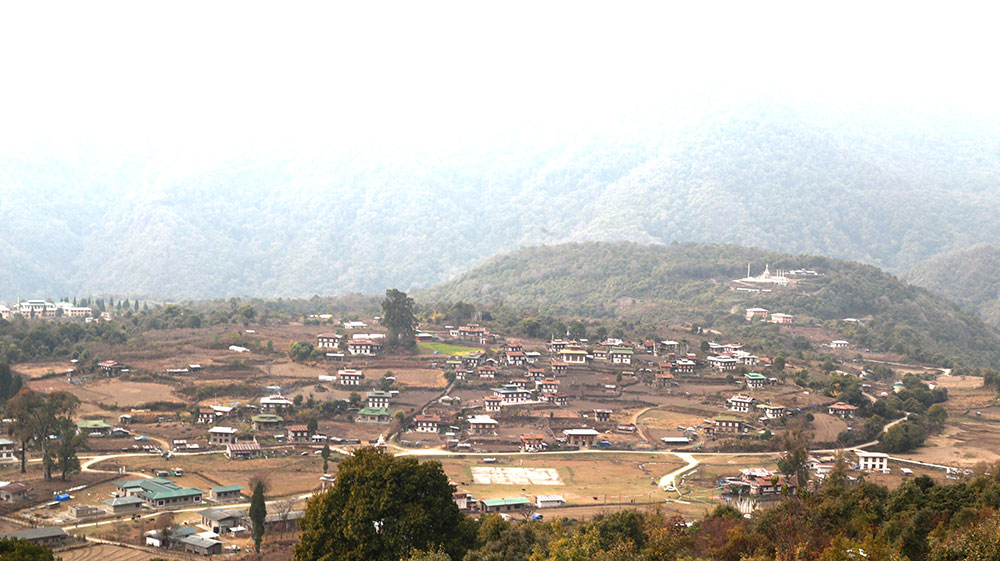… with no holistic solutions in sight
Lhakpa Quendren | Gelephu
Despite implementing various strategies and interventions, human-wildlife conflicts (HWC) have become more frequent, severe, and widespread in Zhemgang in recent years.
People living around the protected areas suffer economic loss as they regularly see their livestock killed and crops damaged without any compensation.
Nangkor Mangmi Sonam said that the gewog has seen an increasing number of such incidents with those living on the forest fringes suffering more damage to livelihood, mostly due to frequent raids by wild boars and tigers.
“As one of the biological corridors passes through Tali village, our communities are at the risk of wildlife damaging crops, livestock, and even human lives,” he said, adding that the issue has become a major challenge to their farming and production.
Farmers say the frequent attacks on their crops by wildlife is seriously affecting their efforts and is a formidable challenge for their livelihood, and increasing agricultural production.
Sangay Lhamo, 33, from Kikhar said that the crops were damaged by wild predators—monkeys during the daytime and wild boars at night. “This discourages us from taking up farming and acres of farmlands have also been left fallow.”
Thirty-year-old Phuntsho Dorji from Khikhar goes to the field every night to guard his crops against invading wild animals. “Monkeys, wild boars, deer, and porcupines often cause severe damage to our fruits and agricultural products that we grow on our little farm.”
With 94.17 percent of its area under forest cover, Zhemgang is home to nature reserves for the Royal Manas National Park, the Jigme Singye Wangchuck, and the Phrumsengla National Parks where over 22 endangered animal species can be found.
The wildlife population, according to the dzongkhag officials, increases as a result of conservation projects and protected areas making human-wildlife conflicts inevitable.
Zhemgang’s officiating dzongdag, Ugyen Lhendup, said that finding the balance between the dual objectives of economic development and the conservation of biodiversity is challenging.
Having rich biodiversity habitats, he said, bears now started coming to nearby villages. “This is also one of the problems on livestock, especially the young calves. We had a recent incident of a bear attack on a human.”
“I think the problem would worsen if we don’t do anything. HWCs are on the rise—conflicts with monkeys, tigers, wild boars, and bears,” he said.
Dzongkhag chief forestry officer (CFO), Tashi Wangchuk, said that most gewogs are outside the protected areas, but Zhemgang has the highest number of tigers in the country due to a biological corridor.
“Despite the implementation of several strategies to address HWCs through conservation, the matter is only becoming worse,” he said.
Dzongkhag agriculture officer (DAO), Jambay Ugyen, said that the problems of HWCs are also due to the change in the food habits of wildlife. “Wild animals prefer more of our crops and the livestock as they are easy prey.”
Zhemgang Dzongkhag Tshogdu’s Thrizin and Trong Gup, Wangay, said that HWC also occurs due to rural-urban migration. “Many young people move to town in search of jobs. Villages have mostly old people and land remains fallow.”
Villagers also say that since the Mithun breeding farm has moved from Zhemgang to Samdrupjongkhar due to the existence of tigers, pressure has been built on the cattle herds where 10 cattle and four horses were attacked by tigers within a month.
Measures and way forward
While HWC is complicated, there are no holistic approaches. But several mitigation methods including 85 km of electric fencing in the dzongkhag have been supported during the 11th and 12th Plans.
Nangkor Mangmi Sonam, however, said that electric fencing is not sustainable. “The electric fence worked for only three years. We are also creating awareness to take care of the fencings.”
CFO Tashi Wangchuk said that people are not clearing the bushes and grasses around the electric fences. “We need to clean the fencing area frequently because when grasses touch the wires, it doesn’t work.”
Officiating dzongdag Ugyen Lhendup said that since the electric fence uses wooden poles, it gets damaged quickly. “It is also difficult to get the permits to cut wooden poles.”
He said that different control measures would be required for different types of HWC. “The current best practice is electric-fencing. We are not able to use other materials because of the high cost which our farmers cannot contribute.”
Ugyen Lhendup said that there are no concrete solutions to all the human-wildlife conflicts because it is very difficult. “The chain link would protect the crops from wild boar and bears but not from monkeys.”
The government also initiated chain link fencing in HWC hotspots as an interim prevention strategy.
“The agriculture ministry is exploring through donor support and providing free materials to our farmers. But the farmers have to contribute labour,” Ugyen Lhendup said.
“We are pushing the crop insurance with the financial institutions and re-implementing the gewog compensation scheme through the tiger project. They have given 1 million as seed money and farmers agreed to pay the premium. This has been implemented on a pilot project,” he said.
DAO Jambay Ugyen said that the loss of livestock by leopards and tigers has been compensated through the forestry sector and relevant projects. “However, there is no compensation for the damage to crops. The compensation is not possible due to complexity in nature.”
“We have a crop insurance policy in the draft Plan that would be implemented in the 13th Plan. But we need to strategise on how to go,” he said.
Trong Gup Wangay said addressing HWC would not be possible. “Reducing human-wildlife conflict would cost the government hugely because we have to go for chain link.”
This story is supported by the GEF-UNDP Ecotourism Project under the Department of Tourism


